#urea production
Note
me: hmm i’ve heard of anaemia but what’s uremia? *reads the first line of wikipedia* NOPE TIME FOR BED
kfdsjd SORRY
#one day i will learn to stop inflicting knowledge on others#if you actually wanna know#urea is the end product of protein breakdown#blood is made up of proteins#so: blood -> protein breakdown and absorption -> uremia
1 note
·
View note
Text
Newly water soluble fertilizer machine made by Beidou Company
New Established Water Soluble Fertilizer Plant
#wsf plant #fertilizer plant #soluble fertilizer plant
#New machine #NPK #NPKs #316 stainless steel #fertilizer
#fertiliser #fertilizer market #fertilizer industry #farm #agriculture
#farming #farmers #agrotech #chemicalfertilizer #chemicals
#chemical #urea #nitrogen #maizefertilizer #maize #kano
#kaduna #africa #africa business #nigeria #india agriculture
#beidou company#fertilizer production line#bagging machine#fertilizervideos#fertilizersusidy#fertilizer manufacturer#compoundfertilizer#fertilizer industry#fertilizer#urea#chemical fertilizer processing machine; drip irrigation fertilizer machine
0 notes
Text
U.S. Urea Cycle Disorders Treatment Market Is Estimated To Witness High Growth Owing To Increasing Focus on Rare Diseases

The U.S. Urea Cycle Disorders (UCD) Treatment Market is estimated to be valued at US$ 510.0 million in 2023 and is expected to exhibit a CAGR of 3.56% over the forecast period 2023-2030, as highlighted in a new report published by Coherent Market Insights.
Market Overview:
Urea Cycle Disorders (UCD) are a group of rare genetic disorders that affect the body's ability to metabolize ammonia, resulting in its accumulation in the blood. This can lead to serious health complications and even death if left untreated. UCD treatment aims to manage the levels of ammonia in the body through medication and dietary modifications.
The U.S. Urea Cycle Disorders Treatment Market offers a wide range of products and therapies to effectively manage UCD. These include oral medications, protein substitutes, and medical foods. These products help in reducing ammonia levels and improving overall health outcomes for patients with UCD. The market is driven by the increasing prevalence of UCD, growing awareness about rare diseases, and advancements in treatment options.
Market Key Trends:
One key trend in the U.S. Urea Cycle Disorders Treatment Market is the increasing focus on rare diseases. Rare diseases, including UCD, are gaining more attention from healthcare providers, pharmaceutical companies, and regulatory authorities. This is due to the significant unmet medical needs of patients with rare diseases and the potential for innovative treatments.
For example, Horizon Therapeutics Plc and Bausch Health Companies Inc have developed medication for UCD that has shown promising results in clinical trials. These innovative therapies have the potential to revolutionize the treatment landscape for UCD and improve the quality of life for patients.
PEST Analysis:
Political: The political landscape plays a crucial role in the availability and accessibility of UCD treatment options. Government policies and regulations impact drug development, pricing, and reimbursement, which can have a significant impact on the U.S. Urea Cycle Disorders Treatment Market.
Economic: The economic factors influencing the U.S. Urea Cycle Disorders Treatment Market include healthcare spending, insurance coverage, and affordability of treatments. The availability of healthcare resources and funding for research and development also impact the market.
Social: The social factors affecting the U.S. Urea Cycle Disorders Treatment Market include the prevalence of UCD, awareness about rare diseases, and patient advocacy groups. The increasing emphasis on personalized medicine and patient-centric care also influences the market.
Technological: Advancements in technology, such as genetic testing and precision medicine, have opened new avenues for the diagnosis and treatment of UCD. These technologies enable early detection, personalized treatment plans, and targeted therapies for patients.
Key Takeaways:
1: The U.S. Urea Cycle Disorders Treatment Market Demand is expected to witness high growth, exhibiting a CAGR of 3.56% over the forecast period. This growth is driven by increasing awareness about rare diseases and advancements in treatment options for UCD. For example, innovative therapies developed by Horizon Therapeutics Plc and Bausch Health Companies Inc have shown promising results in clinical trials.
2: The United States is expected to be the fastest-growing and dominating region in the U.S. Urea Cycle Disorders Treatment Market. The high prevalence of UCD in the country, robust healthcare infrastructure, and favorable regulatory environment contribute to its market dominance.
#Urea Cycle Disorders Treatment Market#Urea Cycle Disorders Treatment Market Insights#Urea Cycle Disorders Treatment Market Outlook#Urea Cycle Disorders Treatment Market Study#Urea Cycle Disorders Treatment#waste products#genetic testing#precision medicine#healthcare#medical devices#Coherent Market Insights
0 notes
Text
Advantages of chicken manure organic fertilizer production line equipment urea crusher
Urea crusher is an organic fertilizer production line equipment, can crush the material in the organic fertilizer equipment. Urea organic fertilizer crusher belongs to the medium mill. The machine is designed according to the principle of impact crushing. The inner and outer two groups of cage bars rotate in reverse at high speed, and the material is broken from the inside out by the impact of the cage bars. It is a powerful tool for crushing compound fertilizer. Before use, the cage crusher is placed flat in a certain position in the workshop. No need for equipment base, connected to the power supply can be used. The fineness of the grinding is controlled by the distance between the two rolls. The smaller the distance, the finer the fineness, the lower the yield. The better the uniform grinding effect, the higher the yield. This equipment can be designed to be mobile according to user requirements. The user can move to the corresponding position when in use, and can remove it when not in use, which is very convenient.
Urea crusher equipment advantages:
1, simple structure, high crushing efficiency, good sealing performance, smooth operation, easy cleaning and maintenance.
2, simple and compact, small footprint, easy maintenance, easy to clean, is mono-ammonium, diammonium, urea and other hard materials.
3, the two groups of inner and outer cages are relatively high-speed rotation, the material is broken from inside to outside by the impact force of the cage body, which is a sharp tool for crushing compound fertilizer.
4, can be designed to be mobile according to user requirements. The user can move to the corresponding position when in use, and can remove it when not in use, which is very convenient.

0 notes
Text
Organic fertilizer production line equipment urea mill how to use to play a greater effect
Ten tips for the use of urea mill:
(1) The urea crusher should be fixed on the ground and can be fixed with cement. If the working place is often changed, the crusher and the motor should be installed on the frame made of Angle steel.
(2) Before the mill starts, rotate the rotor by hand to check whether the operation of the organic fertilizer equipment is flexible and normal, whether there is a collision in the housing, whether the rotation direction of the rotor is correct, whether the motor and the mill are well lubricized.
(3) After installation, the urea mill should be carefully checked whether it is installed in place, and whether the installation is not firm enough. Whether the motor shaft and the crusher shaft are parallel, and whether the tightness of the transmission belt is appropriate should be checked.
(4) The crusher should not often replace the belt wheel to prevent the speed from being too high or too low.
(5) After 300 hours of urea mill operation, the bearing must be cleaned and the oil replaced; When installing oil, it is better to fill 1/3 of the bearing seat gap, not more than 1/2. The belt should be removed when the machine is shut down for a long time.
(6) The crusher feed should be uniform, if there is noise, bearing and body temperature is too high or spray material outward, should be immediately shut down for inspection and troubleshooting.
(7) Before the work of the crusher, the staff should carefully check the materials to prevent hard objects such as metal and stone from entering the crushing chamber and causing accidents.
(8) When feeding, the staff should stand on the side of the reed crusher to prevent being injured by the debris bouncing out. Do not grip the long stalk too tightly to prevent the hand from being brought in.
(9) Stop feeding before stopping, wait for the material in the machine to be cleared, and then cut off the power to stop. Cleaning and maintenance should be carried out after shutdown.
(10) The mill should be idled for 2 to 3 minutes after starting, and then feed after no abnormal phenomenon.

0 notes
Text
हिंदुस्तान उर्वरक और रसायन लिमिटेड के बरौनी प्लांट ने यूरिया उत्पादन शुरू किया
हिंदुस्तान उर्वरक और रसायन लिमिटेड के बरौनी प्लांट ने यूरिया उत्पादन शुरू किया
हिंदुस्तान उर्वरक और रसायन लिमिटेड (एचयूआरएल) के बरौनी प्लांट ने यूरिया उत्पादन शुरू कर दिया है। देश ने बरौनी में इस नए अमोनिया यूरिया प्लांट को स्थापित करके एक और मील का पत्थर हासिल किया है। अत्याधुनिक गैस आधारित बरौनी प्लांट सरकार द्वारा फर्टिलाइजर कॉरपोरेशन ऑफ इंडिया लिमिटेड (एफसीआईएल) और हिंदुस्तान फर्टिलाइजर्स कॉरपोरेशन लिमिटेड (एचएफसीएल) की बंद पड़ी यूरिया इकाइयों को पुनर्जीवित करने की एक…
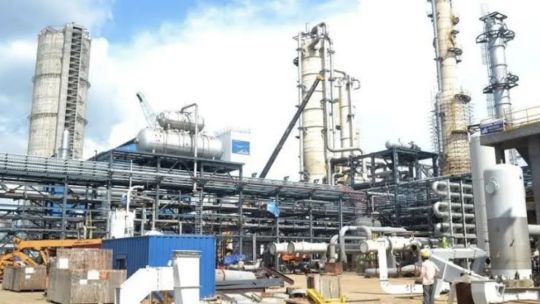
View On WordPress
0 notes
Text
Kidney Diseases, Types and Diagnosis
Kidney Diseases, Types and Diagnosis
Kidney diseases can affect one or both kidneys, which are located on the left and right sides of the abdomen, in the middle of the back. They are bean-shaped and approximately the fist-sized. They are vital organs that remove toxins and extra water from the body.
What are kidney diseases?
A kidney disease does not occur overnight but develops over a period of time and in stages. Kidney disease…

View On WordPress
#ammonia#creatine#creatinine#end-stage renal disease#Kidney cysts#Kidney Disease#kidney failure#Polycystic kidney disease Polycystic kidney#Stones in the kidney#urea#uric acid#Waste products
0 notes
Text
Maximizing the Productivity and Profitability of Summer Irrigated Greengram (Vigna radiata L.) by Combining Basal Nitrogen Dose and Foliar Nutrition of Nano and Normal Urea.
Field try was led at wetland ranch of Tamil Nadu Agricultural University, Coimbatore, during summer season, 2022 with a target of amplifying the efficiency and benefit of greengram by embracing shifted portion of basal nitrogen and foliar utilization of nano and ordinary urea at Flower Initiation (FI) stage and 15 days from that point. The examination was spread out in factorial randomized block plan and recreated threefold with the accompanying medicines viz., N1 - 100 percent RDN (25kg N ha-1), N2 - 80% RDN (20kg N ha-1), N3 - 60% RDN (15kg N ha-1) and N4 - Control as variable I, and F1 - Nano urea @ 2ml liter-1 of water, F2 - Nano urea @ 3ml liter-1 of water, F3 - Nano urea @ 4ml liter-1 of water and F4 - 1% urea as component II. The trial results uncovered that, 100 percent RDN and nano urea foliar shower @ 4ml liter-1 of water altogether enrolled higher ripeness co-effective (71.2%), cases plant-1 (38.5 Nos.), seeds unit 1 (12.7 Nos.) and greatest grain yield (1291 kg ha-1). In any case, it was comparable to the use of 80% RDN and nano urea foliar shower @ 4ml liter-1 of water, which recorded ripeness co-productive of 70.6%, 38.0 units plant-1, 12.6 seeds unit 1 and grain yield of 1289 kg ha-1. In financial matters point of view likewise, use of 100 percent RDN and foliar supplement of nano urea @ 4ml liter-1 accounted greatest gross return (₹100114 ha-1), net return (₹53549 ha-1) and advantage cost proportion (2.15), which was practically identical with utilization of 80% RDN and foliar use of nano urea @ 4ml liter-1 of water at FI stage and 15 days from there on. In view of the exploratory outcomes, it is presumed that decreased utilization of basal nitrogen i.e., 80% RDN with nano urea foliar splash @ 4ml liter-1 of water at FI stage and 15 days from there on observed to be the ideal nitrogen portion and nano urea foliar sustenance for amplifying the efficiency and productivity of summer flooded greengram.
See the Link here: journalijpss.com
0 notes
Text
we're sorry folks, but piss kink is way past trendy, its all been covered¹: piss on the floor, piss your pants, piss for, on, and with your pals, piss on a leash, piss in a hole, piss at the brothel, piss et cetera. yah youre funny, but you arent pushing the boundaries, lets go a little further: the piss ran down his leg and mixed with the puddle of blood pooling at his feet. you must purchase a product to be seen as more than an animal. she pisses in a cup to verify her freedom. he pisses on the go, because if he stops moving he dies. they distilled the urea and bonded it with a nitrate ion to form a compound capable of granting autonomy
1. haha covered in peepee.
254 notes
·
View notes
Text
Professor Kangwoo Cho and PhD candidate Jiseon Kim from the Division of Environmental Science & Engineering at Pohang University of Science and Technology (POSTECH) collaborated with the Korea Institute of Science and Technology (KIST) to devise a novel catalyst aimed at enhancing the efficiency of reactions using contaminated municipal sewage to produce hydrogen -- a green energy source. Their research recently featured in the international journal Advanced Functional Materials.
With the growing environmental concerns of pollution associated with fossil fuel, hydrogen has garnered increased interest. Water electrolysis technology is a sustainable process that leverages Earth's abundant water to produce hydrogen. However, the concurrent oxygen evolution reaction during hydrogen production is notably slow, resulting in a considerably low energy conversion efficiency.
Read more.
12 notes
·
View notes
Note
hsfjdlshfks I'm imagining that angel Akechi still talks about piss but it's actually a successful ploy to prevent Teruhashi from developing any interest in his humansona and also prevents the Kokomins from seeing him as any sort of threat. Saiki refused to follow his gross (but wise) advice and this has made his job 80x harder rip XD
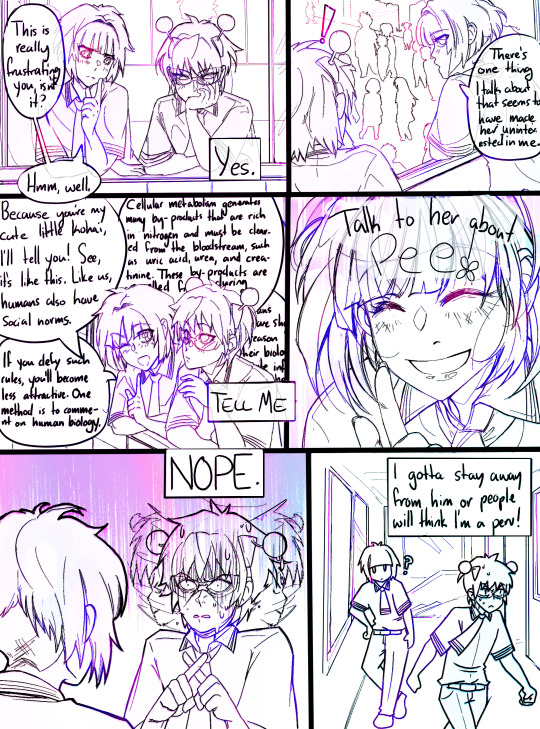
RIP Akechi :"(
"This is really frustrating you, isn't it?"
[Yes.]
"Hm, well. There's one thing I talk about that seems to have made her uninterested in me. Because you're my cute little kouhai, I'll tell you! See, it's like this. Like us, humans have social norms. If you defy such rules, you'll become less attractive. One method is to comment on human biology. Cellular metabolism generates many by-products that are rich in nitrogen and must be cleared from the bloodstream, such as urea, uric acid, and creatinine. These by-products are expelled from the body during urination. Humans are shy about their biology for some reason-"
[Tell me.]
"Talk to her about pee!"
[NOPE.]
[I gotta stay away from him or people will think I'm a perv!]
"?"
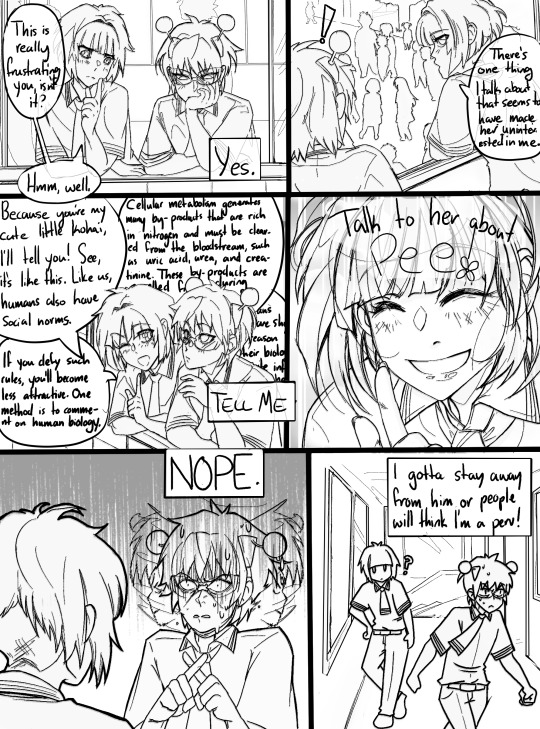
#had me on the entire fucking floor alk;djf;laksdjf;lkdj jfc#freak gets asks#guardian angel au#saiki k
160 notes
·
View notes
Text
Many rural people will be surprised to see how polluted their air is, but that’s because the media seldom mention the major source of these particles: ammonia from farms. A study by researchers at University College London found that even in cities, ammonia from farms produces more particulate pollution than the cities themselves do. Farm ammonia contributes 25% of the PM2.5s in London, 32% in Birmingham and 38% in Leicester, while these cities generate from 13-24% of their own PM2.5 pollution (the rest blows in from mainland Europe or comes from construction and road traffic outside the city, shipping emissions and dust from distant deserts).
Where there is public silence, lobbyists rule. The ammonia comes from livestock farms and the manure and fertiliser spread on fields. There are several ways of greatly reducing its release: storing manure in sealed tanks rather than open lagoons, injecting it into soil instead of spreading it, banning the use of urea as a fertiliser, reducing the animal products we eat. According to a paper in the journal Science, cutting ammonia pollution is 10 times more cost-effective than cutting nitrous oxide pollution, another major cause of airborne particulates. Halving ammonia emissions, another analysis suggests, could save 3,000 lives in the UK every year. Reducing ammonia, according to Andrea Pozzer of the Max Planck Institute for Chemistry, is the “most effective way to reduce mortality linked to air pollution”.
10 notes
·
View notes
Photo

A glimpse into the very first processes that could have formed life on Earth A new technology has shed further light on the age-old question: what are the origins of life on Earth? Before life was formed on Earth, what scientists dub the pre-biotic condition, the atmosphere was less dense. This meant that high energy radiation from space was omnipresent and ionized molecules. Some hypothesize that small water puddles containing urea - an organic compound essential for forming nucleo bases - became exposed to this intense radiation, causing the urea to undergo conversion into reaction products. These would serve as the building blocks of life: DNA and RNA. But to learn more about this process, scientists needed to dive further into the mechanism behind the urea's ionization and reaction, as well as the reaction pathways and energy dissipation. An international collaborative group comprising corresponding author Zhong Yin, currently based as an associate professor at Tohoku University's International Center for Synchrotron Radiation Innovation Smart (SRIS), along with colleagues from the University of Geneva (UNIGE) and ETH Zurich (ETHZ), and the University of Hamburg, have been able to reveal more thanks to an innovative X-ray spectroscopy approach. The technology, which harnessed a high-harmonic generation light source and a sub-micron liquid flat-jet, enabled researchers to examine chemical reactions occurring in liquids with unparalleled temporal precision. Crucially, the groundbreaking approach allowed the researchers to investigate the intricate changes in urea molecules at the femtosecond level, that is a quadrillionth part of a second. "We have shown for the first time how urea molecules react after ionization," says Yin. "Ionisation radiation damages the urea biomolecules. But in dissipating the energy from the radiation, the ureas undergo a dynamical process which occurs at the femtosecond time scale." Previous studies that examined molecule reactions were limited to the gas phase. In order to expand this to the aqueous environment, which is the natural environment of bio-chemical processes, the group had to engineer a device that could generate an ultra-thin liquid jet, with a thickness smaller than one millionth of a meter, within a vacuum. A thicker jet would have impeded measurements by absorbing a portion of the X-rays employed. Yin, who acted as lead experimentalist, believes their breakthrough does more than answer how life on Earth formed. It also opens a new pathway in the novel scientific field of attochemistry. "Shorter light pulses are necessary to understand chemical reactions in real time and push the boundaries in attochemistry. Our approach enables scientists to observe a molecular movie, following each step of the process along the way." IMAGE....Photoionization-induced proton transfer between two urea molecules in an aqueous urea solution. CREDIT Ludger Inhester
17 notes
·
View notes
Text
join me in pell (piss hell)
Let's talk kidneys!
Your kidneys are situated:
Inferior to the liver and the suprarenal glands
Superior to the ureters
Anterior to the posterior wall of abdomen and diaphragm
Posterior to the peritoneum (sack with yer guts in it)
Their job is to:
Regulate blood ions (like sodium) and control blood pH
Maintain blood volume (by extracting or conserving water)
Secrete hormones
Excrete toxic waste (urea, ammonia, creatinine…)
Guess what shape they are. Go on, guess.
YEAH THAT’s RIGHt – IT’S BEAN TIME, BITCHEs

[CW: beneath the cut you will find CT images of kidney trauma]
(and here is some very basic anatomy, sketched on… that same bean)
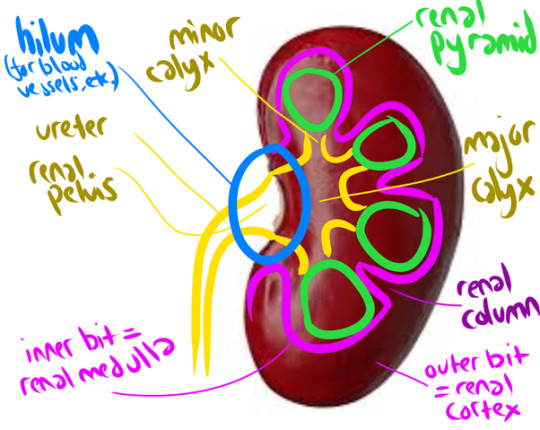
The renal cortex + renal pyramids together form the PARENCHYMA, aka the functional bit of the kidneys (aka where your peepee is made)
But HOW is that peepee made, I hear you cry?
Lemme introduce you to my good friend
The Nephron
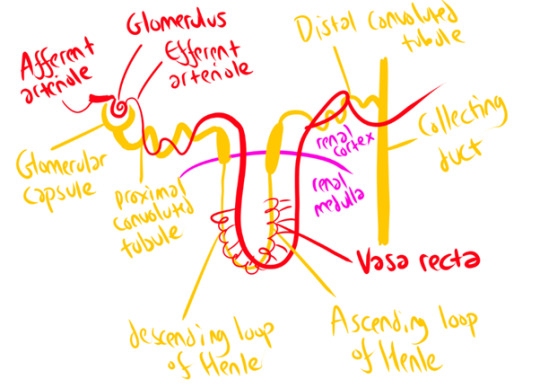
The afferent arteriole carries blood to the Glomerulus (which isn’t actually some weird DnD spell – just a knot of arteries surrounded by the Glomerular Capsule!) This arteriole then slims down considerably to form the efferent arteriole. This pressure increase forces loads of waste products and water out of the bloodstream into the glomerular capsule – but the holes in the arteriole wall are too small to release blood cells, plasma proteins, and other large molecules. This part of the nephron is called the ‘corpuscle’ (again, not a DnD spell). It’s where your blood plasma gets filtered!
The arteriole then follows the nephron around its windy path, wrapping around it at several points – notably the proximal/distal convoluted tubules, and the Vasa Recta that runs parallel to the Loop of Henle. To horrifically simplify a complex process, this provides lots of opportunities for secretion (Bad Stuff to be squeezed out of the blood – those dangerous ions and waste products we talked about earlier!) and selective reabsorption (Good Stuff (water) gets squeezed back in). It’s a careful balancing act, orchestrated in part by hormones! The end result (theoretically) is that all the stuff you DON’T want is shlorped into the nephron as urine, and all the water you need is shlorped back into the blood.
Once your kidneys have produced your peepee, it takes a fun rollercoaster ride through a series of ducts and tubes! Collecting duct -> papillary duct -> minor calyx -> major calyx -> renal pelvis -> ureter -> urinary bladder -> urethra -> you know the rest.
Your kidneys produce 180 litres of fluid a day (aka, a hell of a lot) but most of this is reabsorbed in these little nephrons, with water & useful solutes going back into the bloodstream! As a result, you only pee about 1-2 litres a day (though I swear I feel closer to the 180 litres some days)
Because kidneys are SOOOO important (your body does NOT like to be full of urea/ammonia/sodium, or acid!) they’re really, really vascular (lots of blood supply). They receive up to 25% of your resting cardiac output! So, when you’re just chilling, literally 25% of your blood is being gobbled by those hungry, hungry kidneys!
This means the kidney is VULNERABLE TO TRAUMA.
Although kidney trauma can be picked up on Ultrasound, we will take anyone who has suffered abdominal trauma through to CT, as you get better pictures there! We usually use a multiphase protocol – a longer scan, basically – to show us the extent of the injury, with a non-contrast phase (shows calculi clearly), an arterial phase (evaluates any injury to the renal arteries), a nephographic phase (shows renal lesions clearly), and a delayed phase (shows bleeding and injuries to the urinary collection system). Basically, contrast quickly moves to your kidneys from your blood stream, and filters through the collection system – so if we give a bolus of contrast and watch it flood through the renal arteries, then wait a little while, we can see how the kidneys are processing it or if it’s spilling into the surrounding space.
Kidney trauma is graded from 1 (no laceration but a haematoma (bruise) within the kidney capsule) to 5 (kidney torn away from renal vascular system and dying as a result, actively bleeding, structure of kidney shattered). Here’s a grade 5 (Left (looks like the right side of the image)) in comparison to the normal healthy kidney (Right (looks like the left side of the image)). Note the massive visible laceration + huge haematoma!
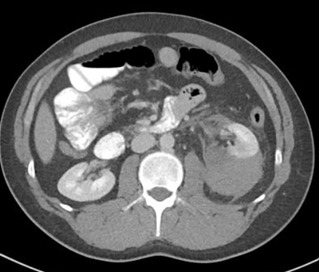

Loooooads of other stuff can go wrong with your kidneys too – but that’s a whole other post! Which I will make, one day soon, because it's super fascinating!
(Have you ever heard of a stag horn calculus? It will put you off holding onto your pee FOR LIFE. If you're sitting there kinda needing the loo but not going... GO NOW. PLEASE.)l
17 notes
·
View notes
Text
Calcium sulphur batteries (uwu)
Okay, so, i've become interested in z-pinch studies for aerospace purposes (i'm really excited about the prospects, everything works on paper, but i naturally want to actually witness p+N14 fusion for above 0.01% of available protons before i go trying to get the materials to build a real liquid fueled SSTO fusion rocket, especially since there are thousands of folks way smarter than me who have presumably thought of this before and we don't have it yet, so yeah). Anyways, if i want the extremely large electricity input without making my electricity bill higher than a whole month's rent and getting my roommates mad at me, i'll need to collect solar or wind in a battery bank. Since lithium batteries are just about all immoral and expensive (yes i am writing this on a device powered by lithium batteries, it would be lovely if capitalists would take a hint and switch to things that just objectively perform better and are cheaper, but whatever), i figured this would be a nice excuse to experiment around with some new battery designs. Since all of them will require sulphur, i won't be able to really get into it before mid may due to some concerns about the smell and risks of getting sulphur powder everywhere (it's very yellow and hard to clean out), but i felt i might as well share my preliminary ideas. First off, in order to make the organic sulphur polymer, i'm looking to explore mostly citrate based polymers, perhaps with phenylalanine mixed in in order to both give more bulk as well as providing nitrogens for sulphenamides to form. Since i'll need urea later, i was also considering partially polymerizing urea with citric acid and adding that into the molten sulphur mix, but i'm less confident in the stability of that and a bit concerned about the potential noxious fumes produced. Regardless, that's the short of the sulphur cathode, details will definitely change after i refind that paper which went over a great way of preventing insoluble polysulphide production.
I'm also gonna experiment with anode material and even the ions i use. I know i said "calcium sulphur batteries" in the title, but due to how common aluminium is and how much easier magnesium is to work with (and the fact that their specific energies are higher), i'll also be considering those two. Even beyond that, there are so many potential anode materials, including even amorphous carbon and carbon nitrides which i'd love to test since there's just so much to improve on and i'd rather do a lot of experiments with cheap to make materials and potentially land on a great solution than accept something subpar because it took less effort. Anyways, of the materials i plan on using, there's magnesium sulphate, aluminium sulphate, calcium chloride, potentially other calcium salts (is the salt with taurine soluble in water? IDK, can't find an answer so i'll test it), charcoal, vegetable oil, urea, and phenylalanine. Those may seem like an unrelated hodgepodge of compounds, but they've been chosen because they're what i have/will soon have and they're also all extremely cheap. If the urea works out well in the battery, i may have to make this project a meme and attempt to make a z-pinch device with as much urine as possible (use it to make ammonia for the plasma, to make the batteries, and i'm sure there's some way to use urine in a capacitor (maybe just distilling off the water to use as a dielectric? idk, it's been a while since i tried making a capacitor)).
Anyway, i really didn't expect this long trainwreck of a post to end with discussions of urine, but what can you do? This is all probably nonsensical, even by my standards, but basically i want batteries and i think i can make them cheaper per megajoule of stored energy than the ones i could buy, even accounting for the inevitable failed experiments.
#utter nonsense#chemistry?#batteries#calcium sulphur batteries are cool i guess#z-pinch shit#almost certainly the beginning of a ton of failures#fortunately i should be able to afford all the chemicals with less than 1 month of income (after rent and utilities and whatnot)#sulphur is so cheap#so am i lol#idk if i want to attempt to make my own solar or wind farm or just buy some turbines or solar cells#turbines are pretty easy so i might build some myself#magnets are relatively cheap and i can use them for other things#and if you know where to look (trashcans behind the college) wire is free#and to make the turbine blades i can just take some sheet metal from the same dumpsters as the wire#alternatively i could just try charging the batteries during off-hours when electricity is super cheap#or making a simple biofuel engine#i should also look into making the capacitors#good bye!
2 notes
·
View notes
Text

Discovering the Key to Bright Skin: The Influence of Skincare Formulations
Preface:
Skincare aficionado Melissa explores a game-changing secret in her engrossing YouTube video that could transform skincare regimens for women between the ages of 40 and 65. With a sense of anticipation, Melissa shares a skincare trick that could revolutionize our routine and provide us with amazing, youthful-looking skin.
The beauty expert reveals her carefully planned morning skincare routine in this insightful YouTube video, which is designed for mature skin over 40. At fifty-five years old, she has a plethora of knowledge in treating a range of skin issues, such as sensitivity, dryness, and aging symptoms. She wants to tackle dark spots, sagging skin, wrinkles, redness, uneven texture, and enlarged pores with her program, embracing the idea of "youthful aging" done with dignity and resolve.
The Disclosure:
Melissa starts off by bringing attention to the startling statistic that 90% of women between the ages of 40 and 65 are ignorant of a game-changing skincare tip. She extends an eager invitation to viewers to find this undiscovered beauty that might completely transform their approach to skincare.
Comprehending the Fundamentals of Skincare:
In order to pique the interest of her audience, Melissa briefly discusses the specifics of her attire and accessories before getting into the main subject. She gives viewers a peek into her unique style with her jewelry and wardrobe choices while also making sure they can easily access product information.
Skincare's Fundamentals:
Taking the stage set, Melissa explores skincare essences, the core of the issue. Using skincare techniques from Korea and Japan as inspiration, she reveals the transformational potential of essences in obtaining youthful, plump skin. Melissa emphasizes the power of essences to hydrate and revitalize the skin from the inside out by defining them as thin, water-based formulations packed with components that plump up the skin.
Illustrating Usability:
Melissa provides a visual demonstration to demonstrate the effectiveness of skincare essences. The presentation highlights how essences prime the skin, paving the way for deeper penetration of future skincare products. She illustrates well-known essence formulas with potent components like urea, copper peptides, and fermentation extracts through a number of instances, each of which has special advantages for the health and vibrancy of skin.
*Useful Implementation and Suggestions:
Giving her listeners more authority Melissa provides advice on introducing essences into regular skincare procedures along with useful insights. From application methods to product suggestions covering various price ranges and compositions, she makes sure that viewers are equipped with the information and skills needed to confidently start their skincare journey.
Welcome to a New Chapter in Skincare:
As the film comes to an end, Melissa muses on the possibility for transformation offered by skincare essences, drawing inspiration from Japanese and Korean beauty customs. She relishes the chance to improve skincare practices and reveal the keys to glowing, youthful skin, and she urges people to embrace this skincare discovery.
My Own Skincare Experience:
The host, looking back on her personal skincare experience, recognizes the difficulties in preserving healthy skin in the face of aging, fluctuating hormone levels, and environmental variables. In order to create a customized skincare regimen, she stresses the significance of knowing one's skin type and specific concerns.
The Morning Routine for Cleaning:
Starting with a revitalizing Beauty by Josan cleanser, the presenter emphasizes how important it is to cleanse in the morning in order to get rid of any leftover oils and pollutants that have accumulated over night. She guarantees the best possible absorption of the next skincare products by getting rid of occlusive ones, laying the groundwork for a rejuvenating skincare regimen.
Making the Most of Essential Ingredients:
The presenter presents powerful formulations that are enhanced with salicylic acid, retinol, hyaluronic acid, niacinamide, and vitamin C. She emphasizes how these ingredients work in concert to counteract different indications of aging. She debunks misconceptions about the effectiveness of vitamin C and promotes well-balanced formulas that produce noticeable effects without endangering sensitive skin.
Specialized Medical Care Regarding Rejuvenation:
In order to promote collagen formation, increase elasticity, and fight sagging skin, the host uses targeted serums, highlighting the importance of peptides and copper peptides in skin rejuvenation. She uses retinoic acid-infused eye creams and specialty moisturizing essences with extreme accuracy to target certain issues around the sensitive eye area.
Result:
The host thanks her audience for their support and participation as she wraps up her in-depth skincare lesson. Urging viewers to place a high priority on self-care and She encourages people to embrace the path of "youthful aging" with passion and commitment by providing skincare knowledge. She says goodbye, inspiring and empowering her audience to start their own skincare journeys, all the while pledging to continue sharing insightful knowledge and building a community of skincare enthusiasts.
To sum up, Melissa's film is an invaluable resource for anyone interested in skincare who wants to take their regimen to the next level. Through her exploration of the enigma surrounding skincare essences and their significant influence on skin health, Melissa encourages her audience to welcome a new chapter in skincare history, one in which women of all ages can attain glowing, youthful skin.
2 notes
·
View notes